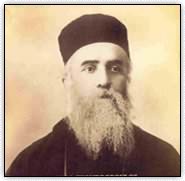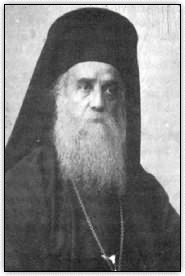|
|
|
|
|
Saint Nektarios of Egina
(1846-1920)
Life of the Saint.

|
|
Our holy Father Nektarios was
born on 1 October 1846 at Selymbria in Thrace. His parents, Dimos and Maria
Kephalas, were pious Christians but not rich in this world’s goods. Their son
was baptized Anastasios and, from infancy, showed great piety and love for
study. When his mother taught him Psalm 50, he liked to repeat the verse: I
shall teach thy ways unto the wicked and sinners shall be converted unto thee.
After finishing elementary school, he was sent by his parents to Constantinople
to continue his education, at the same time as working in a shop. The boy did
not become entangled in worldly cares, but fixed his mind entirely upon
building up the inner man in the image of Christ by prayer and meditation on
the writings of the holy Fathers.
|
When he was twenty, he left Constantinople
for a teaching post on the island of Chios. The young people and villagers
where he taught were encouraged to live in piety and virtue by his words and
above all by the example of his ascetic, prayerful life. On November 7, 1876,
he became a monk in the famous Monastery of Nea Moni, for he had long desired
to embrace the Aesthetic life. Seeking only those things which are above, he
was beloved by all the brethren as the very pattern of gentleness and
obedience, and was ordained deacon after one year. Thanks to the generosity of
a pious islander and to the protection of Patriarch Sophronius of Alexandria,
he was able to complete his studies in Athens and to obtain the diploma of the
Faculty of Theology. In 1885, he arrived in Alexandria where he was soon
ordained priest, then consecrated Metropolitan of Pentapolis (an ancient
diocese in Cyrenaica, in what is now Libya). He was appointed preacher and secretary
to the Patriarch, whose representative he became in Cairo, where he had charge
of the Church of Saint Nicholas.
Nektarios lost nothing of his humility through these honors,
and was able to inspire his flock with zeal for the evangelic virtues. But the love
and admiration of the people for him turned to his disadvantage. Certain
members of the Patriarchate became jealous of his success and, led on by the
Devil, put it about that he was currying favor with the people with the aim of
seating himself on the patriarchal throne of Alexandria. The Saint made no
attempt to justify himself but placed all his hope in the promise of Christ who
has said: Blessed are you when men revile you and persecute you and utter all
kinds of evil against you falsely on my account (Matt. 5:11). He was dismissed
from his Episcopal Throne; and he embarked for Athens where he found himself
alone, ignored, despised and even lacking his daily bread, for he would keep
nothing for himself and gave away what little he had to the poor. The meek and
humble follower of Jesus Christ planned at first to withdraw to Mount Athos but
gave up the idea, for he put the salvation of his neighbor before his own love
of monastic retreat. He spent several years as a preacher (1891-1894) and was
then appointed director of the Rizarios Ecclesiastical School for the education
of priests. The School’s spiritual and intellectual standing rose rapidly under
his direction. The students found in him a teacher with a deep knowledge of
Scripture, of the holy Fathers, and even of secular learning, and a director
who exercised his authority with great kindness and consideration. His
administrative and teaching responsibilities – he taught pastoral theology –
did not prevent him as a monk from living a life of ascesis, meditation and
prayer, nor from fulfilling the high calling of preaching and serving regularly
the holy Mysteries, at the School as well as in the Athens region.

|
|
However, there glowed in the depths of his heart a burning love for the
peace and quiet of life in the monasteries; and this led him to respond warmly
to the desire expressed by some of his spiritual daughters that he should found
a women’s monastery on the island of Egina. This he did between 1904 and 1907
and he retired there in 1908, on his resignation as director of the Rizarios
School. Despite countless cares and difficulties, Saint Nektarios saw to the
restoration of a type of life that was wholly in the spirit of the ancient
Fathers. He gave his utmost bodily and spiritual strength to the construction
of the buildings, to divine service and to the spiritual direction of each one
of his disciples. They would often see him in his worn-out cassock working in
the garden or, when he disappeared for many hours, they would guess he had shut
himself in his cell to raise his intellect to God by bringing it down into his
heart, to taste there the sweetness of the holy Name of Jesus.
Although he desired to flee all contact with the world and strictly limited visits
to the Monastery, the fame of his virtues and of his
|
God-given graces spread in the region, and the faithful were drawn to him like
iron to a magnet. He healed many lay-people and nuns of their sicknesses, and
brought rain to the island in a time of draught. He comforted, consoled and
encouraged; he was all things to all men. He could do all things through Christ
who dwelt in him by the Grace of the Holy Spirit. He kept company with the Saints
and with the Mother of God, and they often appeared to him during the holy Liturgy
or in his cell. During the difficult years that followed the First World War, he
taught his nuns to rely from day to day on the mercy of God. He utterly forbade
them to keep any food in reserve for their use, instructing them to give away to
the poor everything that remained over. Saint Nektarios also found time to write
a large number of works on theology, ethics and Church history, in order to
strengthen the Church of Greece in the holy tradition of the Fathers, which was
often unknown in those days because of Western influences.
Saint Nektarios lived like an angel in the flesh with the rays of the
uncreated light shining around him, yet once again he was calumniated by
certain members of the hierarchy who made malicious accusations about his
monastery. He bore these latter trials with the patience of Christ, meekly and
without complaint, as he did the painful illness which afflicted him for more
that eighteen months before he spoke of it. He thanked God for putting him to
the test in this way, and did his best to keep the pain he suffered secret
until the last days of his life. After a final pilgrimage to an icon of the
Mother of God venerated not far from the monastery, he told his disciples of
his coming departure for Heaven and was taken to a hospital in Athens where, after
fifty days of suffering borne with a patience that edified all who visited him,
he gave up his soul in peace to God on November 8. 1920.
The faithful of Egina, the nuns of his monastery and all the Christians who
had come close to him, mourned the loss of the meek and compassionate disciple
of Christ who, in the likeness of the divine Paso of his Master, endured all
his life calumnies, persecutions and false accusations. But God has glorified
him, and miracles have abounded since his departure for those who approach his
relics with faith or who rely on his powerful intercession. His body remained
incorrupt for more that twenty years, distilling a delicate, heavenly scent,
and then returned to the earth in the usual way. His relics were strongly
redolent with the same perfume at the time of their translation in June 1953.
This perfume has continued ever since to rejoice the faithful who come to
venerate his precious relics with the assurance that Saint Nektarios has been
received by God into the abode of the righteous. His veneration was formally
recognized in 1961. The list of his miracles grows longer every day, and his
shrine at Egina has become the most popular place of pilgrimage in Greece.
Go to the home page
|
|
|
|